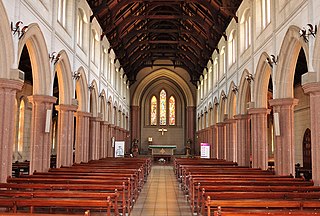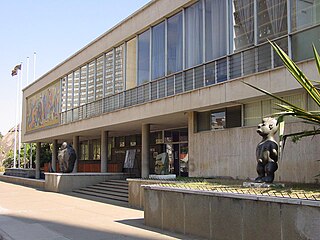Related Research Articles

Bulawayo is the second largest city in Zimbabwe, and the largest city in the country's Matabeleland region. The city's population is disputed; the 2022 census listed it at 665,940, while the Bulawayo City Council claimed it to be about 1.2 million. Bulawayo covers an area of about 546 square kilometres in the western part of the country, along the Matsheumhlope River. Along with the capital Harare, Bulawayo is one of two cities in Zimbabwe that is also a province.

Matabeleland South is a province in southwestern Zimbabwe. With a population of 683,893 as of the 2012 Zimbabwean census, it is the country's least populous province. After Matabeleland North, it is Zimbabwe's second-least densely populated province. Matabeleland South was established in 1974, when the original Matabeleland Province was divided into two provinces, the other being Matabeleland North. The province is divided into six districts. Gwanda is the capital, and Beitbridge is the province's largest town. The name "Matabeleland" is derived from Ndebele, the province's largest ethnic group.

Matabeleland is a region located in southwestern Zimbabwe that is divided into three provinces: Matabeleland North, Bulawayo, and Matabeleland South. These provinces are in the west and south-west of Zimbabwe, between the Limpopo and Zambezi rivers and are further separated from Midlands by the Shangani River in central Zimbabwe. The region is named after its inhabitants, the Ndebele people who were called "Amatabele"(people with long spears – Mzilikazi 's group of people who were escaping the Mfecani wars). Other ethnic groups who inhabit parts of Matabeleland include the Tonga, Bakalanga, Venda, Nambya, Khoisan, Xhosa, Sotho, Tswana, and Tsonga.

The National Railways of Zimbabwe (NRZ), formerly Rhodesia Railways, is a Bulawayo headquartered state-owned enterprise that operates the country's national railway system. It was established in 1893 and governed by an Act of Parliament. It has a commercial-administrative center in Harare and a supply center in Gweru. The Zimbabwean railway system was largely constructed during the 20th century.

Killarney is a suburb of Bulawayo, Zimbabwe. It is named after the town of Killarney in County Kerry in southwest Ireland. It is a low density suburb found on the North Eastern part of Bulawayo. In Killarney, there is a primary school, Centenary Primary school and The Zimbabwe School Of Mines, which is a mining school in Southern Africa. On the outskirts of Killarney there is Old Nic Mine.
Barbourfields Stadium is a multi-purpose stadium in Bulawayo, Zimbabwe, home to Highlanders FC. It is currently used mostly for football matches. It is owned by Bulawayo City Council and is home to Highlanders F.C., one of the biggest soccer teams in Zimbabwe. Soccer fans commonly refer to the stadium as "Emagumeni" meaning "our yard" in iSiNdebele. As of 2017, Barbourfields Stadium may be used as homeground to other football teams in and around Bulawayo including Bantu Rovers FC, How Mine FC and Chicken Inn FC, but mostly, when they play big teams. The stadium consists of four stands including the most famous ones; the Mpilo End, and, of course, the Soweto End. It has a capacity of 25,000 making it the third largest stadium in Zimbabwe after the National Sports Stadium (60,000). and Rufaro Stadium (35000)
Plumtree School is a boarding school for boys and girls in the Matabeleland region of Zimbabwe on the border with Botswana. Founded in 1902 by a railway mission, Plumtree School boards 500+ pupils. Recently the school announced it will start enrolling girls as of January 2016.
Danamombe is a Zimbabwean archaeological site, about eighty kilometres from Gweru, in the direction of Bulawayo and about 35 kilometres south of the highway. It is not often visited due to the poor quality roads in the area. The remains on the site resemble those of Khami. Nearby are the smaller ruins at Naletale, that were occupied at the same time.
Mzilikazi High School, is a government-maintained F1 secondary school named in recognition of the Ndebele king Mzilikazi, the founder of the Ndebele Nation. The School is in the city of Bulawayo, Zimbabwe, located along the Old Falls Road, a road that used to link Bulawayo with the Victoria Falls. It is located very close to the famous Mpilo Hospital of Bulawayo. Mzilikazi High School is physically located between Greenspan Suburb and Mzilikazi Township.

The Roman Catholic Archdiocese of Bulawayo is the Metropolitan See for the ecclesiastical province of Bulawayo in Zimbabwe.
The Roman Catholic Diocese of Umtata is a diocese located in the city of Umtata, King Sabata Dalindyebo Local Municipality, in the ecclesiastical province of Durban in South Africa.

David Coltart is a Zimbabwean lawyer, Christian leader and politician. He was a founding member of the Movement for Democratic Change when it was established in 1999 and its founding secretary for legal affairs. He was the Member of Parliament for Bulawayo South in the House of Assembly from 2000 to 2008, and he was elected to the Senate in 2008. He was the Minister for Education, Sport, Arts and Culture from February 2009 until August 2013. He is a top official of the Citizens Coalition for Change political party which was formed in 2022.

The National Gallery of Zimbabwe (NGZ) is a gallery in Harare, Zimbabwe, dedicated to the presentation and conservation of Zimbabwe's contemporary art and visual heritage. The original National Gallery of Rhodesia was designed and directed by Frank McEwen, a British citizen credited with bringing Shona Sculpture to the spotlight. The Gallery was officially opened by Queen Elizabeth The Queen Mother on July 16, 1957, and Queen Elizabeth II attended the sixth Zimbabwe Heritage Exhibition there in October 1991.

The history of the Jews in Zimbabwe reaches back over one century. Present-day Zimbabwe was formerly known as Southern Rhodesia and later as Rhodesia.

The Natural History Museum of Zimbabwe is located in Bulawayo, Zimbabwe, on Leopold Takawira Avenue.
The following is a timeline of the history of the city of Bulawayo, Zimbabwe.

State House, formerly called Government House, is a former Government House in Bulawayo, Zimbabwe. It was used by the British South Africa Company during their rule in Rhodesia. It was built by Cecil Rhodes in 1897 as his personal residence. It is now used as the official Bulawayo residence for the President of Zimbabwe.

Callistus Dingiswayo Ndlovu was a Zimbabwean academic, diplomat, and politician. He joined the Zimbabwe African People's Union (ZAPU) in 1963 as a teacher in Matabeleland, and went on to serve as its representative to the United Nations and North America in the 1970s. After Zimbabwe's independence in 1980, he was a member of the House of Assembly from 1980 to 1985 and served as a senator from 1985 to 1990. He left ZAPU and joined the ruling ZANU–PF party in 1984.
References
- ↑ "Old Bulawayo". Natural History Museum Of Zimbabwe. 2015-10-13. Retrieved 2019-04-26.
- ↑ Sibanda, Patricia (23 February 2023). "'Old Bulawayo rehab 80% complete'". Southern Eye. Retrieved 2024-02-02.